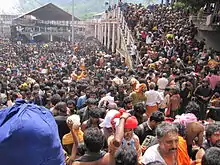Makara Jyothi
Makara Jyothi is a star worshiped by pilgrims at Sabarimala Temple in Kerala on Makara Sankranti every year. It is believed that the deity Ayyappan asserts himself as Makara Jyothi to bless his devotees.

| Part of a series on |
| Hinduism |
|---|
 |
Etymology
Makara (Sanskrit: मकर) is the name of a zodiac sign in Indian languages known as Capricorn in English. Jyoti means "light" in Sanskrit.
Origin and celebration
The Sun moves from one zodiac constellation to another every month. The day on which the Sun changes to a new constellation is called Sankrānti ("transit") in Sanskrit. Makara Sankranti (Sanskrit: मकर संक्रान्ति, Malayalam: മകര സംക്രാന്തി, Kannada: ಮಕರ ಸಂಕ್ರಾಂತಿ, Tamil: தைப்பொங்கல், Telugu: మకర సంక్రాంతి ) is the Sun’s transit into the constellation Capricorn (Makara) that occurs on 14 January and is a Hindu festival celebrated across India. Uttarāyaṇa, the six-month period when the sun travels towards the north on the celestial sphere, starts on Makara Sankranti and ends on Karka Sankranti (around 14 July).
Devout Hindus gather for worship in Sabarimala, which is located in the rain forests of Kerala.
Makara Vilakku
Makara Vilakku is a light that appears thrice on the Ponnambalamedu hill, 4 kilometres (2.5 mi) away from the temple. Historically, it was a pooja performed by tribesmen (mala araya) on the day of Makara Jyothi in Ponnambalamedu. Currently, the celebration is run by the Kerala government with the support of the Travancore devosom board and forest department. The 'Makaravilakku' at Kerala's famous Sabarimala temple is man-made, as confirmed by the Travancore Devaswom Board (TDB) that runs the temple in the Periyar Tiger Reserve (PTR), in its submission to the Kerala High Court. The board told the court that since it is a traditional ritual, it could not be done away with. A bench comprising justices Thottathil Radhakrishnan and Shekhar allowed the board's plea to conduct deeparadhana (evening pooja) instead of Makaravilakku at Ponnambalamedu, where the light appears. The court held that in view of the board's admission about the Makaravilakku, there is no need for further investigations into the matter.
Popularity of the Ritual
Lord Sri Rama and his brother Lakshmana met Sabari, an ardent devotee, at Sabarimala. Sabari offered the Lord fruits after tasting them. But the Lord accepted them gladly and whole-heartedly. The Lord then turned and saw a divine person doing tapas. He asked Sabari who it was. Sabari said it was Sasta. Rama walked towards Sasta and the latter stood up to welcome Prince Ram. The anniversary of this incident is celebrated on Makara Vilakku day. It is believed that on Makara Vilakku day, Lord Dharmasasta stops his tapas to bless his devotees.
The most famous Ayyappa shrine in India is the one at Sabarimala with over 50 million devotees visiting it every year..
The huge crowd of pilgrims that witnesses the event has been on the rise every year.[1] It is believed that 1.5 million devotees witnessed Makarajyoti light in 2010.[2] The revenue collection during the Makaravilakku period was also higher compared to previous years. The total donations were Rs.720 million in 2008 against previous year’s Rs.723 million.[3]
Sabarimala stampedes and authenticity debate
In 1999 and 2011, two major human stampedes occurred on 14 January, Makara Jyothi Day at Sabarimala, killing 53 and 106 people respectively. [4] .[5][6] In 1999 the Justice T Chandrasekhara Menon committee that investigated the stampede refrained from going into the details of authenticity of 'Makara Jyothi'. Committee stated that Makarajyothi is a matter of belief and can't be probed. Justice Chanadrasekhara Menon had probed the veracity of makarajyothi during that time. He also appointed an advocate of the commission to witness the makarajyothi.[4]
In 2011 another human stampede occurred on 14 January, Makara Jyothi Day at Sabarimala. It broke out during an annual pilgrimage, killing 102 pilgrims and injuring more than 100. Amid a renewed debate after this stampede, Kerala High Court wanted to know whether or not the ‘Makarajyothi’ is a man-made phenomenon, asking about the authenticity of the hallowed celestial light visible from Sabarimala. "A distinction has to be made between the Makaravilakku and Makara Jyothi. The Jyothi is a celestial star. Makarvilakku is lit [by people],' said the head of the Thazamon Thanthri family, Kantararu Maheswararu.[7] After this Travancore Devaswom Board (TDB) said that it was known to most believers that it was a man lit-fire, but there was a Hindu belief behind it. "It is known to everybody that Makara Jyothi is a fire lit up by men at Ponnabalamedu and TDB also recognises this', TDB President M Rajagoplan Nair told reporters on 31 January 2011.[5]
References
- "Sighting of 'Makarajothi' brings good luck and blessings". The Hindu. Chennai, India. 14 January 2006. Archived from the original on 29 January 2008.
- "Pilgrims witness Makara Jyothi". Manorama Online.
- "Sabarimala revenue put at Rs.102.52 crore". The Hindu. Chennai, India. 15 January 2010. Archived from the original on 18 January 2008.
- "Makarajyothi: Court intervening after 11 years". Mathrubhumi English. 21 January 2011. Archived from the original on 1 February 2014. Retrieved 18 January 2014.
- "Sabarimala's Makara Jyothi is man-lit: TDB". Times Of India. 31 January 2011. Retrieved 18 January 2014.
- G. Mahadevan (15 January 2011). "Sabarimala stampede: toll rises to 102". The Hindu. Retrieved 18 January 2014.
- "Kerala High Court's poser on 'Makarajyothi'". The Hindu. 20 January 2011. Retrieved 18 January 2014.
